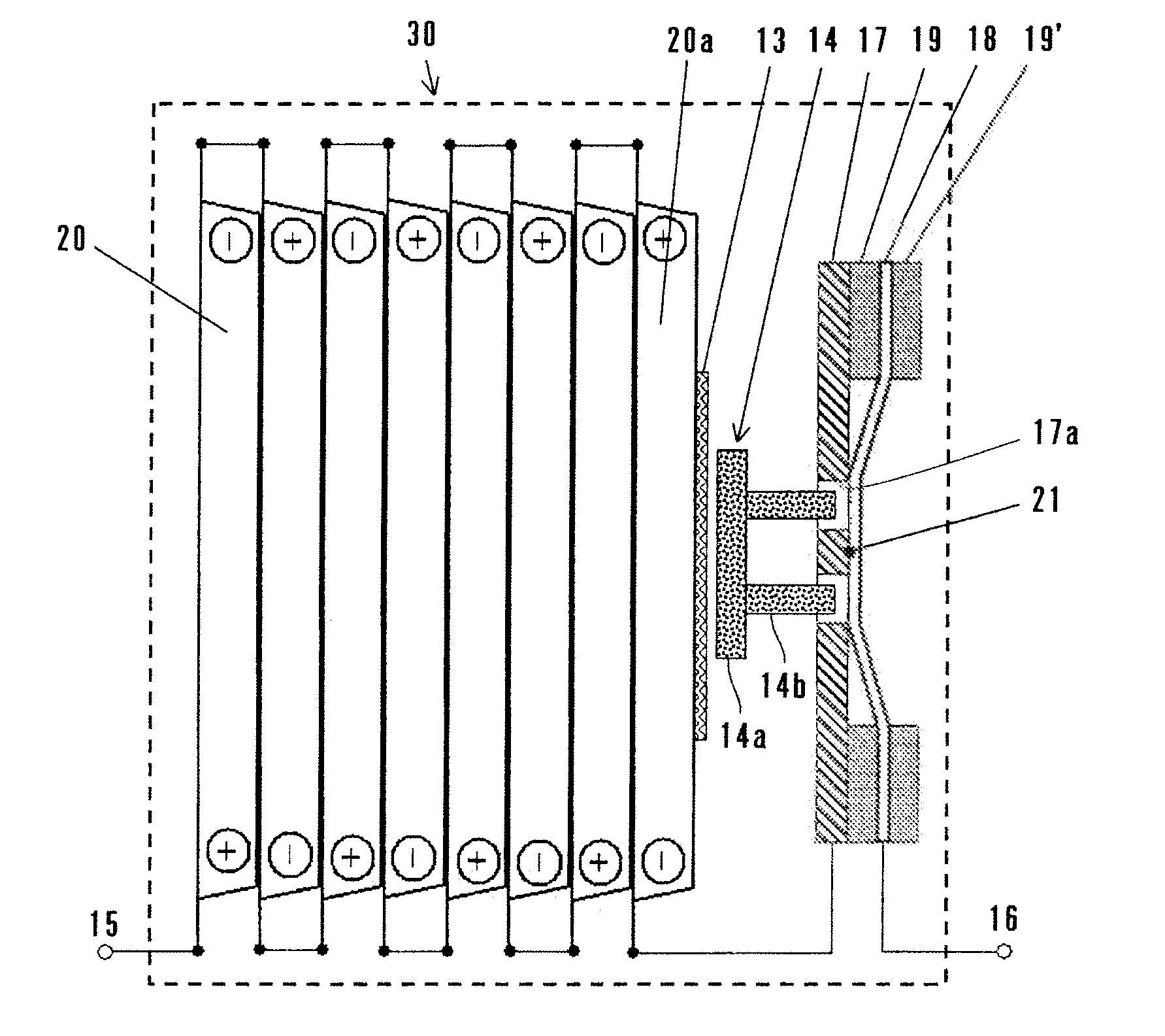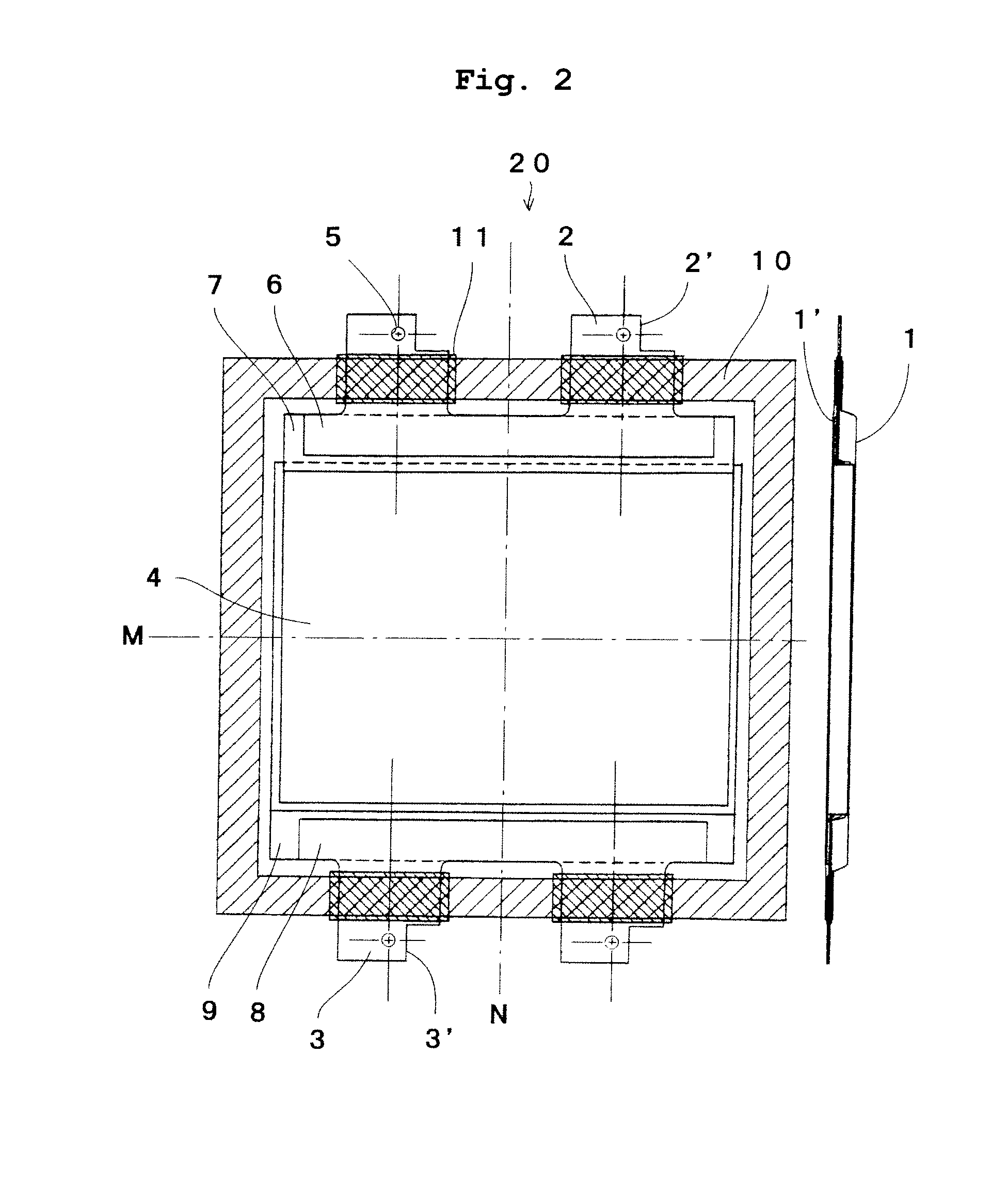Secondary battery module
a secondary battery and module technology, applied in secondary cell servicing/maintenance, cell components, jackets/cases materials, etc., can solve the problems of large restriction on efficiency enhancement, difficult not only to reduce the weight of secondary batteries, but to increase the efficiency of volum
- Summary
- Abstract
- Description
- Claims
- Application Information
AI Technical Summary
Benefits of technology
Problems solved by technology
Method used
Image
Examples
first embodiment
[0020]Hereinafter, a secondary battery module of the present invention according to the first embodiment is described by referring to drawings.
[0021](Constitution)
[0022]As shown in FIG. 1, the secondary battery module 30 (hereinafter, simply a “module”) of the embodiment has 8 pieces of film-type lithium ion secondary batteries 20 (hereinafter, simply as “single batteries” serving as unit cells) each using a laminate film serving as a flexible member for a battery container. In the module 30, the 8 pieces of single batteries 20 and entire components such as a connecting member or the like described later are incorporated into a frame made of an aluminum alloy (not shown).
[0023]Each of the single batteries 20 has plane portions on two surfaces facing each other. The 8 pieces of the single batteries 20 are disposed so that positive and negative electrodes thereof are arranged in an alternating manner. The plane portions of each of the single batteries 20 adjacent to one another are pl...
second embodiment
[0046]Next, a secondary battery module of the second embodiment is described below. Configurations of each of the single batteries 20 and single battery 20a and a structure in which 8 pieces of single batteries 20 are stacked of the second embodiment are the same as in the first embodiment and the same reference numbers are assigned to members or components having the same functions as in the first embodiment and descriptions thereof are omitted accordingly. Hereinafter, points being different from those in the first embodiment are explained.
[0047](Constitution)
[0048]As shown in FIG. 3, the secondary battery module (hereinafter simply a “module”) 40 is made up of 8 pieces of single batteries 20 each using a laminate film as a battery container. An entire module 40 including 8 pieces of single batteries 20 and lead plates described later is incorporated in a frame (not shown) made of an aluminum alloy. Moreover, in the embodiment, a battery capacity of the single battery 20a is 5 per...
example
[0066]Next, an example of the module 40 fabricated according to the second embodiment is described. Moreover, as a comparative example, a module was manufactured in the same method as used in the above example except that the projected portions 32 of the pushing member 24 were removed.
[0067]To check and evaluate safety of modules 40, whether or not ignition occurred when charging was performed on one hundreds of the example modules and the comparative example modules by using a regulated power source at 5 V and 1 CA (3.2 A) to the extent that overcharge occurs. The table 1 shows results from the evaluation of safety.
TABLE 1Tongue-likeprojectedportionIgnitionNo ignitionExamplepresence0100Comparativeabsence1783Example
[0068]In either of above example and comparative example modules, single batteries 20 and single battery 20a expanded due to gas generated internally and the central portions 33 of the lead plate 27 were broken and, as a result, currents are interrupted. Thereafter, in 17...
PUM
| Property | Measurement | Unit |
|---|---|---|
| thickness | aaaaa | aaaaa |
| thickness | aaaaa | aaaaa |
| thickness | aaaaa | aaaaa |
Abstract
Description
Claims
Application Information
 Login to View More
Login to View More - R&D
- Intellectual Property
- Life Sciences
- Materials
- Tech Scout
- Unparalleled Data Quality
- Higher Quality Content
- 60% Fewer Hallucinations
Browse by: Latest US Patents, China's latest patents, Technical Efficacy Thesaurus, Application Domain, Technology Topic, Popular Technical Reports.
© 2025 PatSnap. All rights reserved.Legal|Privacy policy|Modern Slavery Act Transparency Statement|Sitemap|About US| Contact US: help@patsnap.com



